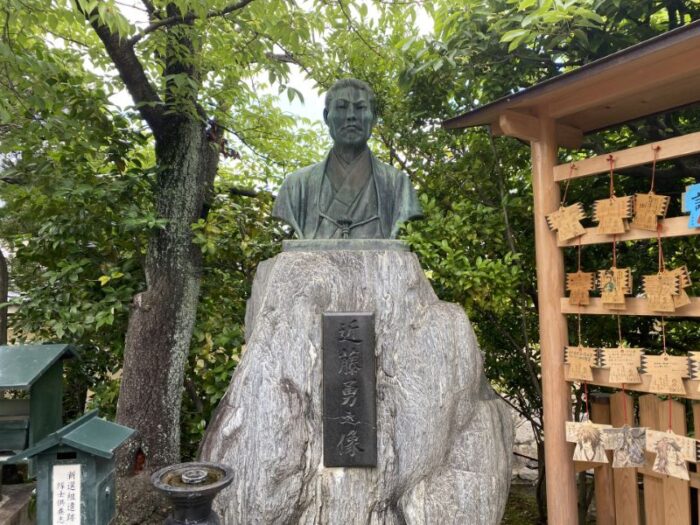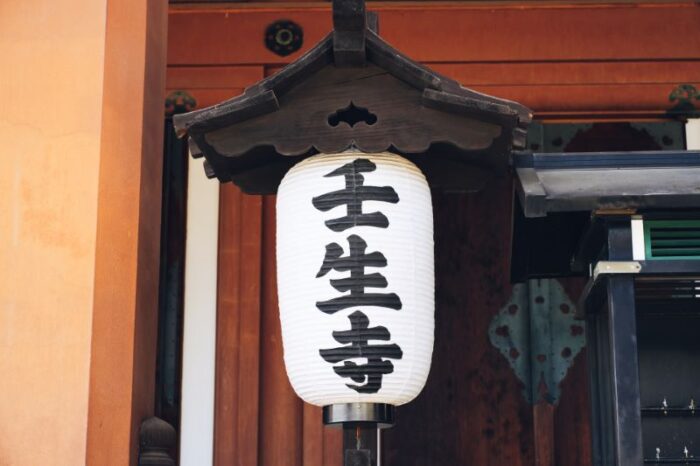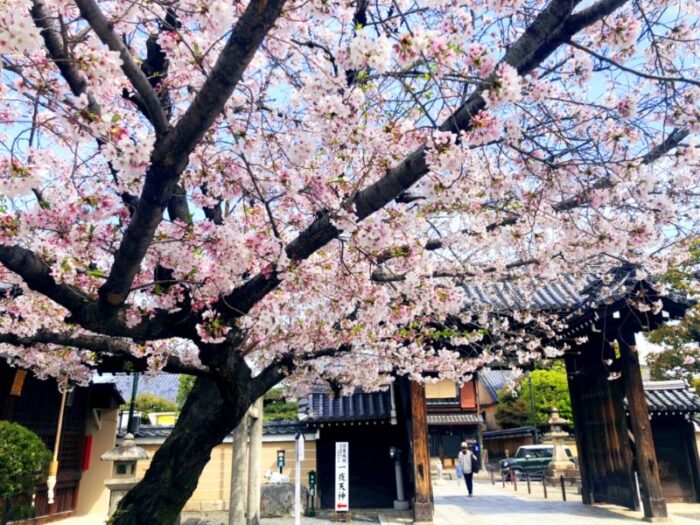Mibu-dera, located in Kyoto, Japan, is a Buddhist temple with a captivating history and cultural importance. The temple’s Mibu-zuka graveyard holds the resting places of eleven members of the renowned samurai group, the Shinsengumi.

Notable for its worship of Jizō Bosatsu, a guardian of children, Mibu-dera is home to the Yonaki Jizō statue, believed to heal childhood illnesses. Visitors can also partake in a wish-making ritual involving the Mizukake Jizō statue.
With its Mibu Kyōgen plays and rich history, Mibu-dera is a must-visit destination for curious travelers.
Key Takeaways
- Mibu-dera is a temple with a graveyard called Mibu-zuka, where eleven Shinsengumi members are buried.
- The temple is dedicated to Jizō Bosatsu, a guardian of children, and has a stone statue of Yonaki Jizō believed to cure illness in children.
- Mibu-dera is famous for its Mibu Kyōgen, farcical short plays performed in between longer nō plays, featuring masks and elaborate costumes.
- The temple has a rich history, being originally established for the Chinese monk Jianzhen and later restored by Taira no Munehira after a fire.
Graveyard and Shinsengumi

The graveyard at Mibu-dera is situated behind the Amida Hall and Benten Hall. It is home to the graves of eleven Shinsengumi members, including the controversial first leader, Serizawa Kamo. Serizawa was reportedly assassinated by his own subordinates.
This graveyard is a place filled with history. It is where the remnants of a group that fought for their beliefs now rest in eternal peace.
Walking through the graveyard, one can’t help but feel a sense of reverence and respect for those who sacrificed their lives for what they believed in. The gravestones stand as a testament to their bravery and dedication. Each name etched into the stone tells a story, a story of honor and loyalty.
It is a reminder that freedom comes at a price, and these men paid it willingly.
Jizō Bosatsu and Children
Revered as a guardian of children, Jizō Bosatsu is the principle object of worship at Mibu-dera. This stone statue, known as Yonaki Jizō, is believed to have the power to cure illnesses in children.
Visitors to Mibu-dera can participate in a special ritual called Mizukake Jizō, where they can splash water on the Jizō statue and make a wish for the well-being of their children. It is a heartwarming and personal experience, as parents and caregivers pour their hopes and prayers into this act of devotion.
The compassionate presence of Jizō Bosatsu at Mibu-dera offers comfort and solace to those seeking protection for their little ones. With its focus on the welfare of children, Mibu-dera creates a nurturing and inclusive space for all who desire freedom and peace for the next generation.
Mibu Kyōgen and Plays

Performers in Mibu Kyōgen entertain audiences with farcical short plays that showcase a range of comical and dramatic stories. These lively performances captivate the audience with their unique blend of humor and wit.
Here are five reasons why Mibu Kyōgen plays are a must-see:
- The plays feature hilarious scenes of an ogre being chased by a woman wielding soybeans, bringing laughter and amusement to all.
- Watch in awe as a demon spider casts its intricate web, creating a thrilling and suspenseful atmosphere.
- Be entertained by the clever antics of thieves stealing clothes, as they attempt to outsmart their pursuers.
- Join in the merriment as guards get drunk and engage in comical mishaps, providing a delightful spectacle for all to enjoy.
- Experience the beauty of traditional masks and elaborate costumes, adding a visual feast to the already captivating performances.
With its engaging storytelling and lively performances, Mibu Kyōgen offers a unique and entertaining experience for those seeking a taste of freedom and enjoyment.
History of Mibu-dera

Established for the Chinese monk Jianzhen, Mibu-dera was originally intended to bring the teachings of Ritsu Sect Buddhism to Japan. The founder of Mibu-dera, Kaiken, was a monk in the Mibu district.
In 991, a chapel dedicated to Jizō Bosatsu was built, and Mibu-dera was bestowed with the status of chokugan-ji by Emperor Shirakawa in 1077. Throughout its history, Mibu-dera has faced destruction and restoration.
After a fire, Taira no Munehira restored the temple, and Dogyo conducted rituals to collect funds for its reconstruction. These rituals, called Yūzū Dainenbutsu-e, became the foundation of Mibu Kyōgen performances.
Today, Mibu-dera is famous for its Mibu Kyōgen and its renowned Jizō Bosatsu statue. It stands as a testament to the enduring spirit of Buddhism and the pursuit of freedom.
Significance of Mibu-dera

Restored by Taira no Munehira after a devastating fire, Mibu-dera holds a significant place in history. This ancient temple not only serves as a place of worship, but also offers a glimpse into the rich cultural heritage of Japan.
Here are five reasons why Mibu-dera is an important destination for those seeking freedom:
- Symbol of resilience: After being destroyed by fire, Mibu-dera was rebuilt by Taira no Munehira, showcasing the indomitable spirit of the Japanese people.
- Connection to the past: Mibu-dera’s history can be traced back to the Muromachi period, making it a link to Japan’s ancient traditions and beliefs.
- Cultural preservation: The temple’s Mibu Kyōgen performances have been passed down through generations, preserving the art of traditional Japanese theater.
- Spiritual sanctuary: Mibu-dera’s dedication to Jizō Bosatsu, the protector of children, offers solace and peace to those seeking spiritual guidance.
- National recognition: Mibu-dera’s status as one of the six most famous Jizō statues solidifies its place as a national treasure, attracting visitors from all over the world.
Frequently Asked Questions
How Many Shinsengumi Members Are Buried in the Mibu-Zuka Graveyard?
The Mibu-zuka graveyard holds the remains of eleven Shinsengumi members. These brave warriors were buried in this sacred ground, leaving behind a legacy that still resonates today.
What Is the Story Behind the Assassination of Serizawa Kamo?
The story behind the assassination of Serizawa Kamo is a controversial one. According to reports, Serizawa Kamo was allegedly assassinated by his own subordinates, which adds intrigue and mystery to this historical event.
What Is the Significance of the Statue of Kondō Isami in the Mibu-Zuka Area?
The statue of Kondō Isami in the Mibu-zuka area holds great significance. It commemorates the second leader of the Shinsengumi and symbolizes their brave and loyal spirit. Visitors can pay tribute to his legacy and honor his contributions to Japanese history.
How Is Jizō Bosatsu Revered as a Guardian of Children?
Jizō Bosatsu is revered as a guardian of children due to the belief that he protects them from harm. The stone statue of Yonaki Jizō at Mibu-dera is said to have the power to cure illness in children.
What Are Some of the Stories and Themes Depicted in Mibu KyōGen Plays?
In Mibu Kyōgen plays, stories of an ogre chased by a soybean-wielding woman, a demon spider casting its web, thieves stealing clothes, and guards getting drunk are depicted. These performances are held in February, April, May, and October.
The Sum Up
To sum it up, Mibu-dera is a captivating Buddhist temple in Kyoto, Japan. It offers a glimpse into the rich history and cultural heritage of the region. The intriguing graveyard housing the graves of Shinsengumi members and the revered Jizō Bosatsu with its healing powers for children are just a few highlights. There is something for everyone to appreciate and learn from at Mibu-dera. The temple’s Mibu Kyōgen plays add an element of entertainment and fun. Its long-standing history and significance make it a must-visit destination for travelers. Don’t miss the chance to explore this remarkable temple and all it has to offer.




